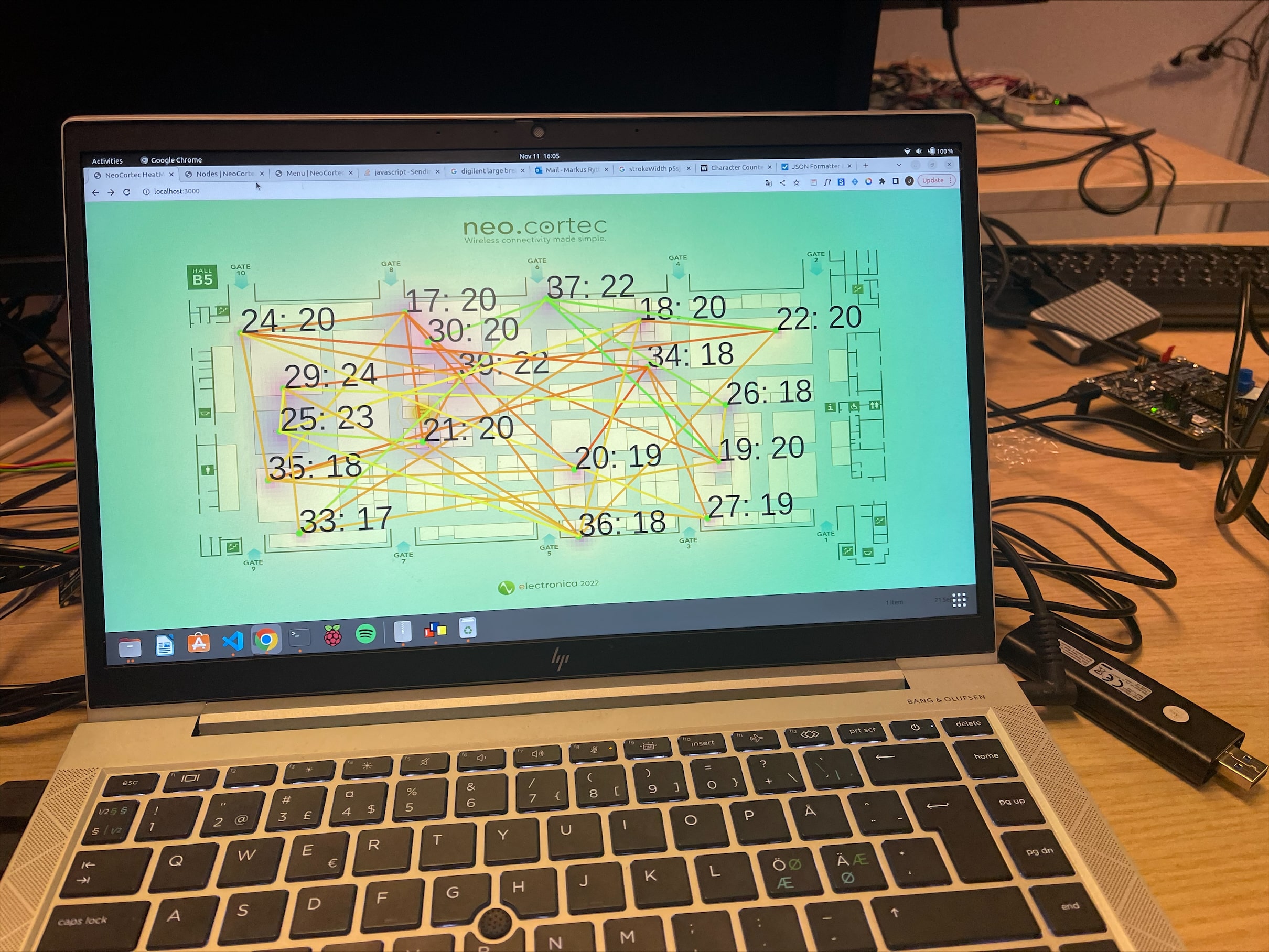
At two recent major trade shows, Electronica 2022 and Embedded World 2023, NeoCortec set up NeoMesh wireless networks in the exhibition halls, aiming to demonstrate to visitors how easy it is to deploy battery-powered NeoMesh-enabled sensors with no requirement for prior network planning or complicated configurations.
Neocortec’s NeoMesh wireless network solution offers great advantages of massive scalability, ultra-low power and ruggedness in comparison with other wireless technologies currently on the market. It is also very easy and quick to set up as it is based on a decentralized mesh of self-governing nodes, which are not dependent on a network coordinator.
NeoMesh network project at Electronica 2022
The project at Electronica 2022 in Munich was undertaken by electronics engineering under-graduate student Markus Rytter, who was challenged by NeoCortec to design and set up an IoT NeoMesh wireless network in Hall B5, where NeoCortec was exhibiting. Twenty-two sensors were positioned around the hall collecting various environmental data like climate values (temperature and CO2 level) as well as detecting Bluetooth-enabled devices currently present in the hall to measure visitor density numbers. Data was uploaded to the cloud and reviewed online with measurements displayed on NeoCortec’s stand for visitors to view and comment. Explained Thomas Steen Halkier, CEO at NeoCortec: “We wanted to show visitors how easy it is to work with our technology. Therefore we challenged Markus to design and implement a sensor network from scratch, allowing him only two months’ preparation to get everything up and running.”
Preparations
Assisted by NeoCortec’s engineering team, Rytter selected a microcontroller and suitable sensors for the project. It was decided to use Nordic Semiconductor nRF52840 devices and Sensirion SCD41 CO2 sensors. The Nordic Semiconductor chip is available on the Adafruit Feather nRF52840 Express board, which is compatible with NeoCortec’s FeatherWing development board.
After getting the first sample module running, Rytter focused on how to count Bluetooth devices that visitors might be carrying. “Of course, getting the Bluetooth scanner working took a while, but it was also fun to figure out the relevant criteria that needed to be met, in order to get an accurate count of Bluetooth devices,” commented Rytter. In the end he decided to scan for Bluetooth devices in the hall every two minutes. Any device that had not been detected after two consecutive scans was removed from the list of Bluetooth devices currently detected in the hall. If a device had been present on the list for longer than an hour, it was also ignored and removed from the list, assuming it to be stationary. This approach enabled Rytter to achieve accurate results for calculating how many people with Bluetooth devices were actually in the hall at a specific time.
With the BLE scan functionality successfully achieved, the next step was to set up a trial NeoMesh network, so that all the different data could be collected and to test that the Mesh network was working as intended. After attaching an antenna to each of the modules, the nodes connected effectively.
Setup at Electronica 2022 and feedback
The NeoCortec team arrived on-site at Electronica 2022 the day before the show opened and positioned twenty-two sensors quickly around Hall B5 on other exhibitor’s stands. All nodes connected easily and formed the network as intended. During the following four days, the project attracted a good number of visitors to NeoCortec’s stand, proving to be a popular demonstration of the NeoMesh technology in action. On a monitor, visitors could clearly see how each module was connecting and communicating with other neighbouring nodes in the hall.
NeoMesh project at Embedded World 2023 sets a world record
A few months later, at Embedded World 2023, NeoCortec continued the NeoMesh network project by collecting temperature and air quality (CO2) data from Hall 3. This time, the information was displayed using the new NeoMesh network monitoring and network visualization tools integrated in the NeoGateway software.
The network management tool automatically monitors the health of the deployed NeoMesh wireless sensor networks. It regularly checks parameters such as network integrity, routing paths, as well as battery level and node temperature. If preset limits are exceeded, the monitoring tool will automatically trigger an alarm, so the problem can be checked and solved. The network visualization tool helps network installers to visualize how the network has formed, and to easily and quickly identify any week points in the installation. It is designed to run on any operating system and will connect to gateways either on the local network, or through a cloud based relay.
It was noted at both exhibitions that the connectivity between the different modules was even better than anticipated and that the nodes created neighbours with other nodes that were not necessarily the closest – sometimes they were as far away as at the other end of the hall. Wireless network and antenna expert Harald Naumann commented that he thought NeoCortec had unknowingly set a world record at Embedded World 2023 by managing to cover the entirity of Hall 3 with a battery-powered mesh network of twenty NeoMesh modules in only twenty minutes.

